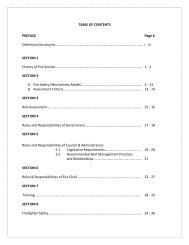Basic Level Pre-Course Reading
Basic Level Pre-Course Reading
Basic Level Pre-Course Reading
You also want an ePaper? Increase the reach of your titles
YUMPU automatically turns print PDFs into web optimized ePapers that Google loves.
Chapter 3<br />
CBRN Assessment and Incident Recognition<br />
Table 3<br />
betas, in comparison, can cause radiological damage from both inside and<br />
outside the body.<br />
Early effects of exposure to ionizing radiation (Table 3) only appear after<br />
very high doses are received during a short period of time. For<br />
comparison to the doses listed, Canadians receive an annual dose of 2-4<br />
millisieverts per year (mSv/y) from natural background sources.<br />
Short-Term Effects of Ionizing Radiation<br />
Dose (millisieverts) Probable Effect<br />
0 – 1000 no detectable injury<br />
1000 – 3000 nausea, vomiting, possible fatality but unlikely for healthy<br />
individuals<br />
3000 – 6000 injury and disability certain, death likely for 50% of people<br />
10,000 – and higher fatal to all people<br />
Low doses of radiation over long periods of time are cumulative. Research on the<br />
effects of long-term exposure has indicated that it can result in an increased risk of<br />
cancer. Studies are ongoing to identify other possible long-term effects.<br />
3.3 CBRN Dissemination Devices<br />
As a first responder or someone who may be involved in the early stages of a CBRN<br />
incident, it is important to know the potential methods of dissemination. This knowledge<br />
may enable responders to recognize, avoid, and minimize the effects of an attack.<br />
There are many methods of disseminating CBRN materials ranging from extremely<br />
basic to very sophisticated. Some of these methods have already been used with<br />
varying degrees of success. The poor performance of some improvised devices may<br />
result from lack of research and limited resources for testing effectiveness; however,<br />
even poor dissemination of a CBRN material can be successful in its intent to injure and<br />
terrorize.<br />
Dissemination devices can be packaged in any shape or size. The outer container may<br />
have visible fans or nozzles. In assessing a scene, it is important that responders take<br />
all indicators into consideration such as the location and design of a device, as well<br />
as the signs and symptoms presented by victims.<br />
Dissemination devices fall into four categories:<br />
• Mechanical Action: frangible or soft containers of solid, liquid or gaseous product<br />
that may be propelled by hand or other means<br />
• Chemical Reaction: the effects of mixing two or more materials to produce a<br />
hazardous substance<br />
• Pneumatic: pressurized gasses used to empty or disrupt containers filled with solid,<br />
liquid or other gaseous products<br />
CBRN First Responder Training Program<br />
26<br />
<strong>Basic</strong> <strong>Level</strong> <strong>Course</strong>

















